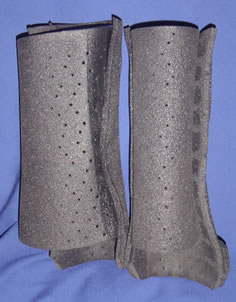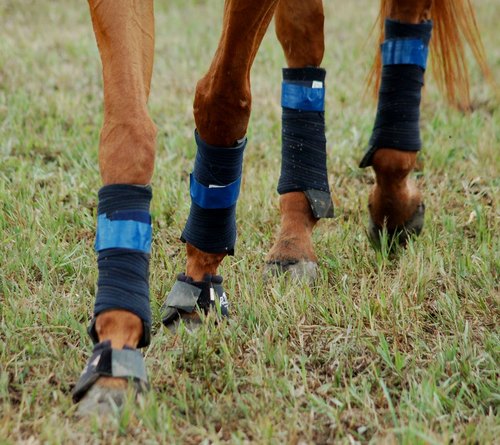Gather ’round, EN readers, and listen to my tale of woe! It’s a story about the fruitless search for what I now perceive as Eventing’s “Holy Grail,” a prize so elusive and crafty that I have devoted countless hours of internet searching and tack shop scouring just to come up empty handed. This longed after but never obtained item is… The Porter Boot.
Kind of Anti-climactic, I know…
What Are Porter Boots:
For those not of the old school eventing mindset, Porter Boots are a form of leg support boot for horses in high intensity disciplines. The boots are most commonly used in eventing, though they are sometimes seen in competitive cross country driving and endurance as well. Comprised of a double layer of tough closed cell foam – one layer as a hard outer shell, the other a supportive inner lining designed to fit the tendons and cup the ankle – these boots are meant to wrap fully around the horses’s canon bones and be secured with vet wrap, Saratoga wraps, or some other form of elastic fastening.
Saratoga wraps – a stretchy wrap with grippy gel bands on the interior, for reduced slipping (Photo courtesy of http://www.bigdweb.com )
Porter boots essentially come in one size that can be cut down to fit the horse’s specific need, and appear to be nearly indestructible as eventing accessories. I know a couple people who have had their porter boots for years and have not yet had to purchase a replacement set! Great value, right? Thats more than I can say for half my splint boots!
Porter Boots and Saratoga Wraps on a Horse (Photo courtesy of braymere.blogspot.com )
The Value of Porter Boots
Porter boots don’t particularly look like anything special, especially not after you’ve taken a pair of scissors to them so they’ll fit ole Trigger. But the level of leg support they offer to an competitive and hard working horse is without parallel, especially considering the price (On average, about $80 for a full set of four). Neither the porter boot neoprene material nor Saratoga wraps hold water weight, so the boots become an asset on a long cross country course. They allow a horse’s legs to remain cool and light without sacrificing all-around leg support and protection to the tendons.

Porter Boots take a licking and keep on ticking! (Photo courtesy of themuckbucket.com )
The Bad News
So perhaps now that you’ve read all this great information about the positive uses of Porter Boots in eventing, you’re interested in getting a pair for yourself. Well, Tough Cookies! Reports via the internet are inconclusive, and everything else is hearsay through the eventing grapevine, but it appears that Mr. Porter (the fabulous inventor of the Porter Boot) has either retired or passed away, and in doing so has pulled production of his product from the market. In short, no one makes or sells new Porter Boots anymore! Oh, the Humanity!
If this were any other piece of riding equipment – bridles, girths, whatever – the situation might not be so dire. After all, there are typically a hundred other companies making a knock off or imitation version of an original brand, usually produced for a cheaper price tag. Such is not the case with the Porter Boot. It appears to have been unique in its field, and to date only one company has managed to offer a product that even comes close to its design and function. That company is, of course, every eventer’s best friend – Nunn Finer.
The Richland Boot (Photo Courtesy of BitofBritain.com )
Currently John Nunn and the Nunn Finer brand are developing their own custom-designed version of the Porter Boot, anticipated to be competitive with the original product both in performance and price. This new design is called the Richland Boot, and you can bet I’ll be purchasing a pair! But while I am waiting on this new solution to my old problem, What am I to use for my Horse’s Leg Protection?!
The Alternative to Porter Boots
It’s not like Porter Boots are the only options available to an eventer wishing to provide protection and support for their horse’s legs. On the contrary, actually. These days there are more versions of wraps, boots, splints, and pads on the market than ever before. And even better, these things now come in Colors! So why am I all hell-bent on purchasing porter boots and saratogas for my horse? Well, a couple of reasons. Let’s review the alternatives:
Woof Boots/Splint Boots – The favorite “go-to” boot of most eventers today, this closed cell neoprene boot provides excellent protection against leg brushing and accidental impact during day to day riding. Their PVC strike pads are very resilient, and the Velcro straps are long lasting (I have a pair that are over a decade old!). I personally love these boots for my daily workouts on my horses because they are quick and easy while also offering the mid level protection I need during training work. However, many of these types of splint boots (whether Woof Wear, Nunn Finer, Davis, or Eskadron) provide little to no tendon support to the horse wearing them, and in fact can even prove harmful by trapping heat beneath the neoprene and in the tendons. This material also absorbs water, making them heavier after a pass through a water obstacle. Ultimately, while I favor these boots for daily workouts and training, they are not my choice for the physical rigors of the cross country phase during competition.
“Tri-Zone” Boots – These boots are less popular than Splint boots, but still a common choice for eventers seeking a cost efficient alternative to some of the more costly cross country boots available. Tri-Zone boots are also made by N.E.W. or Equilibrium, and all provide similar beneficial specs. They feature a hard outer shell (made of TPU) that cups around the back tendon and covers both sides of the cannon bone. Internal padding is made of breathable, impact absorbing EVA, and the front panel of the boot features a dense neoprene plate for added protection over the front tendon and canon. Additionally, Tri-Zone boots have a unique “slatted duct” that allows ventilation beneath the padding to reduce possible overheating of the legs. These boots are truly the next step up from the simple splint boots and provide fantastive impact protection for your horse. Unfortunately, there is still not much in the way of leg or tendon support, and these boots also collect water in the same manner that splint boots do.
The Hunt Continues
In conclusion… no wait, I’m still waiting on a conclusion. I haven’t actually found my perfect set of boots yet. Since writing this, I managed to scrape up a pair of hind Porter Boots from AJ Tack Wholesale, but the fronts are proving particularly elusive. My latest effort has involved buying a second hand pair of hind Porter Boots and cutting them into the shape of the front Porters. This whole experience has turned me into a mad scientist!
I’m sure I’m not the only one who has had interest in Porter Boots (or leg protection in general!), and I know I’m not the only one who uses them. If you’ve got a pair (or are searching for them), please share your stories with me! I’d love to find out that someone has a hidden stash of Porters secreted away in a cave. If they’re willing to share, even better!!
Either way, with Porters, with Splint Boots, even with Duct Tape and a Prayer….
Go Eventing!
























